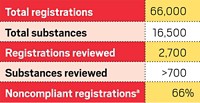Advertisement
Grab your lab coat. Let's get started
Welcome!
Welcome!
Create an account below to get 6 C&EN articles per month, receive newsletters and more - all free.
It seems this is your first time logging in online. Please enter the following information to continue.
As an ACS member you automatically get access to this site. All we need is few more details to create your reading experience.
Not you? Sign in with a different account.
Not you? Sign in with a different account.
ERROR 1
ERROR 1
ERROR 2
ERROR 2
ERROR 2
ERROR 2
ERROR 2
Password and Confirm password must match.
If you have an ACS member number, please enter it here so we can link this account to your membership. (optional)
ERROR 2
ACS values your privacy. By submitting your information, you are gaining access to C&EN and subscribing to our weekly newsletter. We use the information you provide to make your reading experience better, and we will never sell your data to third party members.
Policy
Kick Off Time For REACH
Preregistration for chemical regulation program settles in after a few teething problems
by Patricia Short
July 21, 2008
| A version of this story appeared in
Volume 86, Issue 29

WITHIN A WEEK of the June 1 launch of the preregistration portion of the European Union's REACH chemical testing program, more than 1,000 companies had signed up through the European Chemicals Agency's (ECHA) online registration program, preregistering 4,786 chemicals. By the beginning of July, preregistrations had climbed to more than 15,000.
Although that may sound like a sizable number, it's just a tiny portion of what some experts expect will be 1 million preregistrations for anywhere between 30,000 and 40,000 substances by the time the preregistration process closes on Dec. 1. The chemicals being preregistered were introduced in the European marketplace prior to 1981; chemicals introduced after that time underwent more rigorous premarket testing and don't need to go through the new certification process.
The jump on preregistration that some companies are getting is an indication that the acrimony and controversy that accompanied the development and final promulgation of REACH is dying down. Companies have turned their attention to living with what has been described as the most massive set of regulations ever enacted by the EU.
REACH is the EU's program for registration, evaluation, and authorization of chemicals. By introducing one set of regulations applicable throughout the EU, the program supersedes a hodgepodge of regulations that had accumulated in the different member countries over the past few decades. It establishes several categories of rankings, based on volumes produced and consumed and perceived hazard levels. It also applies to both individual chemicals, or substances, and finished products, or articles, that contain chemicals. All definitions have been set by the European Commission and the European Parliament, and these bodies established ECHA, which is based in Helsinki, Finland, to administer REACH.
REACH establishes a staggered time period for manufacturers and importers to provide full safety dossiers on their chemicals. The deadline for each substance depends on how much of it is made and its hazard category. However, if a manufacturer or importer wants to take advantage of the staggered registration, which can go up to 2018, the chemicals must be preregistered. Otherwise, they cannot be sold in the EU after the beginning of 2009 without immediate full registration.
Jo Lloyd, director of the REACHReady program of the Chemical Industries Association (CIA), a U.K. trade group, says the industry's mantra must be: "No data, no market." Preregistration, she insists, "is a relatively simple process that has been likened to shopping online."
In fact, adds her colleague Tim Jessel, director of business development at CIA, although the regulatory program will have a major impact on all of industry, "it's easy to do more work than you really need to." For preregistration, he suggests, companies don't need to turn to the proliferation of consultants offering REACH services.
Lloyd and Jessel ran the REACH Corner at the Chemspec Europe specialty chemical trade show, held last month in Munich, Germany. Presentations over two days discussed basic facets of REACH—the who, what, how, and when of its implementation. Chemical-using industries such as cosmetics and agrochemicals were covered. Speakers addressed the more arcane aspects of REACH implementation, such as the consortia being formed to pool the gathering of safety data for particular chemicals.
Preregistration is free and simple, Lloyd pointed out in her keynote presentation at Chemspec. Preregistration does not commit a registrant to future production, she added. It is strictly a "just in case" safeguard to protect its markets starting next January.
According to ECHA, a preregistration file for a substance consists of three basic pieces of information:
The substance identity. ECHA said in June that 98% of the first batch of preregistrations it had received relied on standard identifiers such as CAS or IUPAC names.
The envisaged deadline and production quantity for the registration.
The name and contact information of a company or third-party representative who will act as the contact point for data sharing. This can be a manufacturer, an importer, or a customer using the chemical.
The substance identity is particularly important, ECHA staffers stress, because it will help the agency assign potential registrants to the same Substance Information Exchange Forum. A SIEF will be formed for each preregistered substance as a means for companies to share data and other information. The goal is to reduce duplication of tests, particularly animal tests. Producers can also form voluntary consortia to divvy up tasks in collecting and analyzing test data.
Chemicals produced in very limited quantities, primarily for R&D purposes, may be exempt from the preregistration requirement, although a notification requesting an exemption for this status must be submitted to the agency, ECHA staffers say.
An indication of the ease of preregistration came early in June, when the BYK division of German specialty chemical producer Altana crowed that it completed REACH preregistration in only four days. BYK "is one of the first companies in the chemical sector to complete the official preregistration within the framework of the REACH regulation, completing the undertaking by June 4," Gerald Kirchner, head of product development at BYK, said last month. "For our customers, this means maximum and earliest possible certainty that our products remain available as normal."
Less than a week later, the European division of Saudi Basic Industries Corp. reported that it had begun preregistering its slate of chemicals???both those produced at its sites in Europe and those that are imported from Saudi Arabia.
For BYK, a smallish specialties company with 2007 sales of $613 million, completion of the job was helped by the fact that, as Kirchner noted, only around 70 of BYK's own manufactured products with an annual tonnage of more than 1 metric ton are affected by REACH.
BY CONTRAST, BASF, Europe's largest chemical maker, figures that it will have to register, and will probably preregister, some 2,500 substances.
BYK's experience also points out the importance of communications and relationships up and down the chemical supply chain. According to Kirchner, the company's customers have been able to receive up-to-date information on REACH since August 2006 in numerous BYK seminars and workshops.
Similarly, in May, BASF hosted a REACH seminar in Berlin. It was devised for manufacturers, users, and importers of chemicals from all branches of industry, the company says. BASF experts provided information on topics such as product analysis and registration and on strategic issues relating to product safety and responsibility for the environment.
Because REACH will cover all chemicals imported into the EU—either as identifiable entities or incorporated into finished products—its impact will be felt around the world. Readiness for the program is spotty, reports indicate.
REACH Registration Will Continue Through 2018
June 1, 2007
REACH becomes operational.
European Chemicals Agency established in Helsinki.
June 1–Dec. 1, 2008
Preregistration takes place.
Jan. 1, 2009
Chemicals not preregistered cannot be sold or imported in European Union.
December 2010
Registration required for chemicals produced at 1,000 metric tons or more per year, for chemicals of very high aquatic toxicity in volumes of 100 metric tons or more per year, and for extremely hazardous chemicals in volumes of 1 metric ton or more per year.
June 2013
Registration required for chemicals in volumes of 100 to 1,000 metric tons per year.
June 2018
Registration required for chemicals in volumes of 1 to 100 metric tons per year.
For example, following a survey they conducted in March, consultants at PricewaterhouseCoopers concluded that companies based in North America are less well prepared for REACH compared with those in the Asia-Pacific region and in Europe itself.
One indication of the seriousness with which Asian companies are taking REACH could be seen in the REACH Corner at Chemspec. One session was conducted in Mandarin Chinese, and about 30 people, Chinese exhibitors and delegates at Chemspec, were busily taking notes and asking questions of the speaker, Yasmin Yuying Chen, senior regulatory consultant at Copenhagen-based 3E Co. Europe. In another sign of the importance that Chinese companies are ascribing to REACH, a group of Chinese manufacturers and exporters has set up an office in Helsinki, near the ECHA headquarters, for close access to the agency.
FOREIGN MANUFACTURERS can be represented in the preregistration and registration processes only by an appointed representative located in the EU. That person is responsible for fulfilling REACH obligations, ECHA says, including memberships in SIEFs and consortia.
Already, industry groupings are forming consortia, even before ECHA assigns SIEFs. For example, in March, tin producers and consumers announced the formation of an inorganic tin compound group that aims to minimize REACH-related costs and resource requirements. The group is encouraging potential new participants, including all manufacturers, EU importers, and users of inorganic tin chemicals to join.
And on a more basic level, formation of a lower olefins and aromatics (LOA) consortium is on track, says the trade association European Chemical Industry Council (CEFIC). The LOA consortium is open to any company, European or otherwise, manufacturing or importing these compounds. Downstream users and other data holders are also invited to play an active role in the consortium, says Pierre de Kettenis, executive directorof CEFIC's petrochemistry industry sector.
REACH has seen some hiccups—perhaps not surprising for the beginning of such an ambitious project. For a few weeks after the June 1 launch, for example, would-be preregistrants swamped ECHA's REACH-IT online registration software, causing delays and breakdowns. That's important because ECHA is taking preregistrations solely through its online gateway.
At the same time, the software could not cope with multiple registrations of chemicals by a company. Instead, a company had to fill out a full preregistration form for each chemical, rather than listing several on the same form. ECHA had hoped to have the problems ironed out by mid-June, but it hasn't to date.




Join the conversation
Contact the reporter
Submit a Letter to the Editor for publication
Engage with us on Twitter